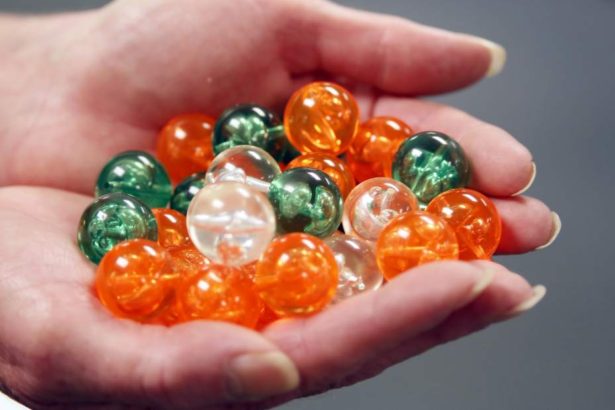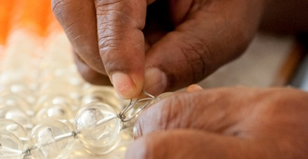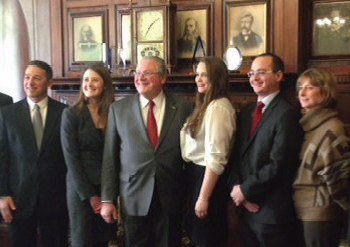Local beads star in art installation
- On October 30, 2014

The Beadery, in Hope Valley, owned by Toner Plastics, is producing over 350,000 round acrylic beads for a large art installation called 360 degree Vanishing Point in Houston TX. Barbara Gordon, the sales and marketing manager holds some of the beads that are being shipped to Texas.
HOPE VALLEY — On Dec. 6, a giant art installation consisting of 400,000 beads will open in Houston, and every one of those beads was made in Hope Valley.
The project, called “360 Degrees Vanishing,” is a collection of huge beaded tapestries created by visiting artists from South Africa that will be attached to the exterior walls of the Art League of Houston.
The beads are being made by The Beadery, a large order that company owner Steven Graham said he was happy to fill.
“We are the oldest bead manufacturer in the US. I think it’s 81 years now,” Graham said. “We were thrilled that they reached out to us.”
Graham, who, with his wife Jean, co-founded Toner Plastics of Springfield, Mass., acquired the nearly bankrupt Beadery, formerly the Greene Plastics Corporation, in 2013. The company currently has 37 full-time employees.
“We bought The Beadery in February of 2013, about two weeks before they were going close the doors. They were in bankruptcy. It’s a very, very old firm that has done a great job over the years, but they ran into trouble,” he said.
Graham explained that because the art project was such a large order, the company was making and shipping the beads in several batches.
“I think it was August when we shipped the first order. They’re ordering quite a few beads, so they don’t need them all at once. They’re all hand-made,” he said.
Houston Art League Executive Director Michael Peranteau said the league wanted to use American-made products in the project, and they were delighted to find The Beadery.
“The issue for us has been that we could buy the 400,000 beads from somewhere cheaper. The only other place is China, and it’s not that we have anything against China, but we wanted as much as possible for the products to be American,” he said.
The beads will cost approximately $30,000, but Peranteau explained that The Beadery had become a sponsor of the project, which helped lower the cost of the American-made beads.
“The difference between the United States and China is so huge in terms of the cost of the beads,” Peranteau said. “We didn’t want to go to China, so we stayed with The Beadery and kept buying piecemeal, and then they became a sponsor, which helped us with the final part of the beads.”
The project is the creation of Houston-based artist Selven O’Keefe Jarmon, who spent several years in South Africa watching South African artists making and selling beaded items. When Jarmon learned that beading, a central element of South African culture, was dying because young people weren’t interested in learning the craft, he decided to create a giant installation that would showcase South African beaders’ talents and skills.
Sixteen beaders, many of whom live in small villages and had never seen a large city, traveled to Houston in three teams to do the beadwork and train the 225 volunteers who assisted with the project. Each of the teams of beaders has stayed for 40 days.
“Out of the 16 beaders, I think 15 of them had never been on an airplane. The first group, some of them had not been on an escalator or an elevator. So they’re literally coming from a place where some of them still carry water to their houses. So to come and be in a city of 6 million people — I have no idea what it must be like,” Peranteau said.
Bulelwa Bam, of the Eastern Cape and Provincial Arts Council, has been in Houston since July overseeing the teams of beaders.
Bam said she was surprised by the numbers of people who wanted to volunteer on the project, something that doesn’t happen in her home country.
“Back in South Africa, when you call people to come and volunteer, you must be prepared to pay them, so people are used to that,” she said. “Our beaders have been quite surprised that people just volunteer their time and they don’t expect anything in return.”
The beads, which measure about ¼ inch each, are wired to 10 X 14 inch sections of a metal grid. When the sections are assembled into the giant tapestries, they will then go up on the league’s walls. At the end of a year, the installation will be taken apart and small sections will be sold to collectors.
“We’re doing three sides of the building,” Peranteau said. “The first side is laid out in a warehouse. And then there’s the front side, which they’re working on now, and then there’s the big side. So I guess they’re halfway through. The date it’s going to be dedicated is December 6.”
Bam said that for traditional beaders used to working on small pieces, the Houston project is an immense undertaking.
“Our beaders are used to beading mostly accessories, and maybe embellishing clothing with beads. This has never been done. It was also the first time to see and to also have an understanding that people are not only limited to accessories. You can take it to the next level,” she said.
Graham said he was looking forward to the opening of the installation, and he said he hoped the focus would be on the art and the artists, rather than the supplier.
“We’re not the big story in this,” he said. “It’s the people from South Africa who came over to teach the craft to some local artisans in Houston. It’s the idea of beading in and of itself as being one of the oldest crafts in the world, one that has a lot of meaning to many people. I think that’s where the emphasis will be, not so much on the supplier of the beads.”
Click here for the original article written by Cynthia Drummon for The Westerly Sun.
Click here to see the original newspaper article.


